Boiler Blog - Herts Boilers
 Herts Boilers also maintain this blog site: https://www.boilerblog.co.uk/
Herts Boilers also maintain this blog site: https://www.boilerblog.co.uk/
Boiler and Heating Technical Blog
Prev |
1 |
- British Gas fixed price repairs - are they real?
- What is a reverse circulation?
- Radiator balancing - Balancing a central heating system
- What should I do if a single radiator is not hot?
- The pressure drops over a period of time, is this a problem?
- Can a modern condensing boiler deliver an over 100% efficiency?
- What are the pros and cons of a boiler manufacturer fixed price repair?
- How can I flush a heating system by DIY?
- Do I really need a powerflush?
- Expansion vessel - is my expansion vessel okay?
- My heating system is losing pressure on a daily basis, what is the problem?
- www.boilerblog.co.uk - our new blog site
- My carbon monoxide alarm went off once, is it 100% dangerous?
- Worcester-Bosh boilers, are they really good?
- British Gas said I need a new boiler, is it really true?
- When replacing with a new boiler, should it always be a combi boiler?
- How do I top up a combi boiler's water pressure?
- Mystery leaking on a combi boiler?
- What is the best heat only boiler in the current market?
- Smart TRVs for each radiators, are they good?
1. British Gas fixed price repairs - are they real?
Fixed fee repairs have some interesting details in the small print, as I found out recently when I didn't fancy repairing a boiler myself.
Not surprisingly, BG came up first in my search, offering to sort out the problem for £69. Or FROM 69 quid rather. Typing in the requested postcode, raised it to £89. Still, a good price, so I rang them.
After giving my name and address, the girl immediately asked for some credit card details. A bit reluctantly, she did give some further info. Yes, £89 was the all-in price to sort the boiler out. Yes, inclusive of parts labour and VAT.
“So, £89 will get the boiler repaired, no matter what the problem is?”
After a slight pause, I was informed that if it took more than 30 minutes, the price would go up to £269. Not exactly a huge surprise to me, apart from the 30 minutes. If we reserve a modest 10 minutes for showing the chap the boiler, unpacking and repacking tools and doing the paperwork, that leaves not much more than 20 minutes actual working time before the extra £180 is due. Ouch!
Still, £269 as a maximum to get a bad problem sorted, didn't seem to be too bad. Let's ask, just to be sure: “Right, so £269 will get the boiler working perfectly, no matter what the problem is?”
Another slight pause. Well, no, if the job takes more than 2 hours, the price would go up to £529!!!!!
Gosh! That is more than the price of a new budget boiler complete with flue, clock and VAT. Still, it is significantly less than a new Bosch or Vaillant, not to mention the installation cost.
So, I asked the same question again: “Will £529 give me a perfectly working boiler, no matter what the problem is?”
It turns out that there was no guarantee it would.
529 squid would only guarantee bringing the boiler back to work if there was only ONE fault. If after 121 minutes of work it turns out there is a second fault, the clock is reset and the bill jumps up again, presumably to £618 provided the second fault takes less than about 20 minutes to find and resolve.
Admittedly, I didn't actually double check that after 31 minutes into the second fault if the bill would reach £788, but as she didn't mention anything about second faults being cheaper than first faults, it seems fair to conclude there is no such discount, and it would be indeed 788 notes.
I can't wait for the next time somebody tells me I'm too expensive because BG will do it for £69.
(Copied from bengasman at the Combustion Chamber, Last edited on 28/11/2012)
2. What is a reverse circulation?
In summer, when you turn off the central heating you still get hot radiators when the boiler is heating the hot water cylinder. This is sometimes caused by an installation error called "reverse circulation".
Here is the explanation of reverse circulation and remedial methods:
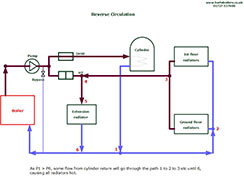 Reverse circulation can only happen in the following conditions:
Reverse circulation can only happen in the following conditions:
1. It is not going to happen on a combi system, ie, reverse circulation can only happen in a system which has a cylinder for hot water.
2. It has probably happened after adding some new radiators to an existing system, eg, new radiators were added after a new loft conversation, so the T-off point is not correct.
3. Not very common, but after a new boiler was installed, and the installers got return pipe configuration wrong.
3. Radiator Balancing - Balancing a Central Heating System
Radiator balancing or balancing radiators goes by several titles. You'll also hear it called balancing the central heating system. Unless it's referring to a warm air central heating system or underfloor heating it all means the same thing, ensuring that all the radiators get equally hot. Ideally they will all get hot together, at about the same time. If all your radiators get hot pretty evenly you don't need to balance the heating system. Adjusting radiator valves can sometimes make them leak, so don't turn them if you don't need to.
Before you try balancing, it's important to make sure that the radiators have been bled (that is, all the air trapped at the top of radiators has been released). If some of your radiators are hot at the bottom but cold at the top (even the very top) you need to bleed the radiators before balancing the heating system. If you bleed a lot of air out of a radiator with the system warm, the water entering the radiator to replace the air may make the radiator hot. You'll only really know whether the radiators need balancing if you start from cold.
Also, before attempting to balance radiators, make sure the pump is not set to too low a speed. Try turning it up; it shouldn't pose problems. If it causes your system to pump water over into the feed and expansion tank (known as the F+E tank or the header tank) or causes air to be pulled down the open vent pipe into the system you may have to slow the pump down again. This usually indicates a system design fault or a blockage somewhere.
Balancing radiators is simple, it just takes a little time. There are more complicated methods but the following method works fine for us. We don't use thermometers and we judge radiator temperature by touch.
There are some basic things you need to know to balance radiators but they're simple too. If you're not sure of any of the terms, follow the blue links for an explanation then come back here.
Almost all radiators have 2 radiator valves, generally at the bottom on opposite ends. (Some very old systems may have one at the top and one at the bottom on opposite ends; some newer systems have both valves at the bottom in the middle of the radiator.)
Water enters the radiator through one valve (the flow end or flow valve) and leaves the radiator through the other valve (the return end or valve).
Usually we are restricting a lockshield valve. Different manufacturers' valves turn a different number of times from fully open to fully closed. Some turn only 2½ turns and some as much as 5 or 6 turns. If your valve turns 2½ turns from open to closed, closing it by 80% means 2 full turns closed (or only ½ a turn open). If it turns 5 turns open to closed 80% closed means 4 full turns closed (or only 1 turn open).
If you close a valve on the flow end by 80% or more, the gap left open in the valve is so small that even a small air bubble coming in with the flow can become trapped in the valve and stop the flow. It may sound daft but it happens. If the flow valve is fully open and you restrict the return valve, any air bubbles come through the flow valve and rise to the top of the radiator, safely out of the way. They don't enter the return valve which is substantially closed so they don't block it and stop the water flowing through the radiator.
The type of valve fitted is not a guarantee of which is the flow and which the return end. To be sure, start with the heating system cold and go round checking which end of the radiator (which pipe or valve on each radiator) gets hot first. Mark the end in some temporary way; a bit of tape will be fine. Sometimes slightly colder water coming along the flow pipe from a different part of the house can deceive you, making the flow end temporarily cooler than the return end. Check again as they warm up to be sure.
You may need to be quick moving round the radiators because a very small radiator connected to a powerful boiler like a combi may get hot too quickly to be sure which end is which. If necessary, check the smaller radiators first. You can check them in any order and if you've marked them with tape you'll know you've checked them all.
If a central heating system needs balancing we start by opening all radiator valves fully, both flow and return. Adjusting radiator valves is not without its consequences, it can make the valves leak. If you're not sure how to deal with leaking valves, read that section first.
Different parts of the central heating circuit have different resistance to water flow. Generally, the nearer a radiator is to the boiler, the quicker it will get hot. In a well designed and installed heating system little balancing is needed.
With all the radiator valves now fully open, if all the radiators become similarly hot in a similar time there is not much more to do and your radiator balancing is completed. If not, and "not" is usually the case, we go to the radiators which get hottest quickest and restrict the flow through them. We set no fixed order in which to restrict radiator valves except to do the hotter radiators first. This pushes more flow through the remaining, slower, radiators. Where possible we always restrict the flow on the valve on the return end (the cooler end) and there's a good reason for this. To balance a poorly designed system it may be necessary to close a valve more than 80%, perhaps even 90%. Let me explain what I mean.
Having restricted the return valves on the hottest radiators by 50% or 60% to start with, we wait to see what happens. Cooler radiators will start to get hotter. Some previously cool radiators may get fully hot. If some are still cool we go round again, restricting all the hotter radiators, some which we restricted before get closed down even more (always, if possible, on the return end) and some which weren't restricted first time round are restricted this time because they are now hot. Again we wait to see what effect we've had and again, if necessary, we restrict the hotter radiators. We'll do it yet again if necessary.
Hopefully this process brings the radiator system into balance; you'll only know for sure when you heat the system up again from cold. If you close a valve down too far, that radiator will cool down and may go cold. Just open the restricted valve a little (10% of its total travel between closed and open) and see if that sorts it. Open it progressively more if you need to.
If balancing radiators doesn't resolve the problems, and no matter how you try you still have some cold or very slow radiators, there are two likely causes. First is a failing pump (but make sure someone hasn't partially closed one of the pump isolation valves). Check to see whether you can turn up the pump speed. Second likely cause is sludge build up and partial blockage of pipework or of an air separator. We would always opt to try changing the pump before trying a process like power flushing to clear possibly blocked pipework.
4. What should I do if a single radiator is not hot?
If all other radiators are hot but only one is not, it is probably a problem only related to this particular radiator. You need to do the followings:
- Set boiler heating output temperature to between 80% - 100% on full scale.
- Set pump power to max (from 1 to 3), if you have an external pump.
- Open both valves on each side of the radiator. For lockshied valves, use a spanner if necessary.
- For a TRV valve, sometimes TRV pin is stuck at its closed position. You need to free the pin, by following some YouTube clips (keywords: "TRV pin stuck"). Here is one.
- Bleed air out from the inside of the radiator. After bleeding, don't forget to top up some pressure if it is a sealed system.
- Balancing the whole system. See above Blog 3.
The above procedures are for general house holders to DIY. Otherwise you should expect to pay a minimium of one hour labour for a plumber to do the job.
5. The pressure drops over a period of time, is this a problem?
In a system with good quality radiator valves and no microscopic leaks, it is possible for the system pressure to hold up adequately between annual services. Most people seem to find that they have to top up a few times a year, and some people more often. If you find that you are needing to top up more than once a week, it might be worth trying to find the problem or see if the relief valve is leaking and the expansion vessel is flat. If topping up annoys you (or it’s awkward) then you might be able to get the system to hold pressure better by adding an internal leak sealer such as Fernox F4. This seals very small leaks but it is worth checking if the boiler manufacturer allows its use, especially if the boiler is still under guarantee.
6. Can a modern condensing boiler deliver a over 100% efficiency?
It is impossible! As flue gas temperatures are still higher than ambient air temperatures, some energy is lost through flue gases. You can’t beat the law of physics, and the conservation of energy.
On average, a modern boiler has around 90% overall energy efficiency.
But why do we sometimes get figures quoting a boiler’s efficiency as being over 100%? This is due to a misleading calculation by some boiler manufacturers.
In St Albans, we have another good gas engineer, Ian Braithwaite. He is not only good at boiler repairs, he is also good at boiler theory. Here is one of his writings about boiler efficiency calculation, which explains the way in witch over 100% energy efficiency calculation is achieved.
7. What are the pros and cons of a boiler manufacturer fixed price repair?
Most boiler manufacturers are offer a boiler repair service for their own boilers, at around £300. So, we call it as a Fixed Price Repair.
The advantages are: 1. Their own engineers are competent on their own boilers. They are much better than most of our independent gas operatives. 2. These engineers have most of the parts or spares in their vans, so it is more likely they will fix the boiler on a first visit. 3. The price from a manufacturer is capped. Even if a part plus labour exceeds £300, they still carry out the repairs as agreed.
But the disadvantages are: 1. If you have a simple problem, they will still charge you £300. 2. In winter times it will take days for them to come out. 3. They only repair boilers and not the heating system outside the boiler.
8. How can I flush a heating system by myself?
As a boiler repair man, I don't often suggest a powerflush as I am able to fix most problems on boilers and heating. A powerflush is very expensive (around £500 - £600), but sometimes it is necessary. If someone is good at DIY, he or she can always try to flush their heating system by a chemical flush.
Here is a good DIY guide on chemical flush:
9. Do I really need a powerflush?
 I have just came across this comment about powerflushing which we totally agree with. If a local heating engineer, or even British Gas, suggested a powerflush to you, as Mike4, an experienced heating engineer in the Combustion Chamber at www.diynot.com, says you are advised to seek a second opinion before throwing away over £500 for a probably unnecessary powerflush
I have just came across this comment about powerflushing which we totally agree with. If a local heating engineer, or even British Gas, suggested a powerflush to you, as Mike4, an experienced heating engineer in the Combustion Chamber at www.diynot.com, says you are advised to seek a second opinion before throwing away over £500 for a probably unnecessary powerflush
10. Expansion vessel - is my expansion vessel okay?

There is a key component in all sealed heating systems (such as combi boilers or megaflow systems) called expansion vessel which deals with the expansion of system water. An expansion vessel can be inside a combi boiler, or inside a system boiler, or at an external position (not inside a boiler) in a sealed heating system. Regardless of what type it is and where it is located, the expansion vessel needs to be checked and charged with a proper amount of compression air in every two or three years.
With the expansion vessel being good by a compression air charge, when heating is on and your radiators are getting hot, this system pressure can go up a bit for example over 2 bar but it should still be less than 3 bar.
Expansion vessels are there to deal with water expansion in a heating system when boiler is on. If an expansion vessel doesn’t have a good air charge, it will give you a frustrated pressure reading and require a frequently topping up.
But in our experience of 15 years in heating industry, 70-80% of expansion vessels on existing boilers or systems are depleted, eg, without enough air left inside, and over 50% combi boilers are having no air in expansion vessels at all. This is usually due to a lack of boiler services, or due to the incompetency of heating engineers who had got involved with these boilers before.
11. My heating system is losing pressure on a daily basis, what is the problem?
This section is only for losing system pressure on a daily basis. If you lose a system poressure every two weeks or so, you might want to have a read on here.
The physics is very simple - there is a leak somewhere in the system! The leak can only be at one of these three points: 1. the boiler pressure relief valve (PRV), or 2. the boiler main heat exchanger, or 3. on external pipes and valves. To find out the actual point where a leak is occuring is sometimes not straightforward and solved by just one visit, so we wrote this Diagnosis Strategy to help our customers understanding the problem.
Diagnosis Strategy - exclusively written by Herts Boilers
As a Herts Boilers standard policy, we offer "no fix no fee" on most of our repairs. But unfortunately with a pressure problem on a sealed system we charge by the number of visits, not by the outcome, although we will do our best to find the leak and get it fixed. The reasons for this exception are: 1. if it is the boiler's main heat exchanger that is leaking, some customers will go for a new boiler, or we don't always get main heat exchanger replacement jobs. 2. We are not experts at external pipe leak fault finding (external pipes mean the pipes outside the boiler which are all over your house).
Once your boiler is losing pressure on a regular basis, it is also advised to check around your house, eg, is there any radiator valve leaking, is there any wall corner that is damping, or is there any wet floor board?
12. www.boilerblog.co.uk - our new blog site
Starting from around 30th March 2020, we began staying home to avoid the dreadful Covid-19 virus. So, there was plenty of time to spend a few days on WordPress with a right theme and an SEO plugin, Boiler Blog stories have really commenced from May 2020.
This is one of our achievements when the whole country was in lockdown due to Covid-19.
13. My carbon monoxide alarm went off once, is it really dangerous?
Not always! More than 50% of them are false alarms. As each callout will cost you or your landlord money, we suggest you do the following checks before calling a gas engineer or Cadent (National Grid).
Check the expiry date on the alarm, change the batteries (in applicable), and take the alarm outside in fresh air for a reset, then put alarm back near boiler or in kitchen, and carefully monitor the situation again. If it is okay, it was probably a false alarm. But if it does go off again, stop using the boiler or other gas appliances immediately, and call a gas engineer for help.
Cadent or SGN are competent on gas supply chain, most of their engineers are not qualified to work on gas appliances for example boilers, cookers and gas fires. For precaution they just cap off the gas supply and advise customers to call a local gas engineer for further investigation.
14. Worcester-Bosh boilers, are they really good?
Their boilers have simple designs and they are known for their reliable performance.
Worcester use aluminium in all of their main heat exchangers. Compared with the stainless steel heat exchangers used on Vaillant, Viessmann, and Baxi, aluminium has a good heat transfer rate, but bit less length on life span. If from the same boiler manufacturer like Vaillant, the boilers with stainless heat exchangers will be more expensive than ones with aluminium heat exchangers.
WB also uses more plastic parts instead of brass parts.
Worcester Bosch are good at marketing, and they target installers with average competency levels. WB are not in the high end market which only acounts for 5% or so. They are not the industry leader in modulation system controls either.
In the last 20 years, WB has had a terrible design on the hydraulic side of all their boilers, and it is a terrible job for any gas engineer to even change a simple PRV.
Overall, WB offer reliability and slightly over priced boilers.
15. British Gas said I need a new boiler, is it really true?
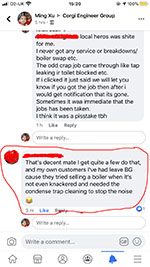 Unfortunately a lot of times it might not be true, they just wanted to sell you a new boiler every time for more sales. British Gas has long been a private company, and each year their sales are targeted to be more than the previous year otherwise the company management will be under pressure for poor performance.
Unfortunately a lot of times it might not be true, they just wanted to sell you a new boiler every time for more sales. British Gas has long been a private company, and each year their sales are targeted to be more than the previous year otherwise the company management will be under pressure for poor performance.
So many times we have come across a situation where the boiler involved can still be repaired, and put back into operation and is still safe. But unfortunately one of British Gas engineers has condemned the boiler.
Another common tactic is to say replacement parts might be obsolete towards a working boiler. It is the same when they said you need a powerflush.
The average competency level of British Gas engineers is still better than most independent local gas engineers. Customers are still advised to use British Gas to repair their boilers if you wish, but not to succumb to any of their hard boiler sales tactics.
16. When replacing with a new boiler, should it always be a combi boiler?
The answer is a big no! Combi boilers are a good invention, eg, they save spaces by not having hot water cylinders, and they give high shower pressure. Compared with megaflow, they are cheaper to supply and install.
But all combi boilers are struggling on these two factors: 1. they can’t support two people taking shower together, and 2. they are working under stress.
If we have a new built estate nowadays in St Albans, there will be two types of heating and hot water systems – some combi boilers are for small or medium size houses, and the rest are system boilers with unvented cylinders, they are for large houses.
A system boiler with an unvented hot water cylinder is also called megaflow. Meaningfully this system will give the best on a shower flow rate and pressure. A megaflow system is expensive than a combi boiler, also with more space required for a hot water cylinder. But both developers and home buyers are still accepting that this system is the best on heating and hot water performance at the moment.
There are still plenty of open vented systems in use, ie, the loft cisterns type. We don't install this type system as new, but you can still replace the boiler like to like if you are still satisfy with overall system performance.
The problem is that some heating engineers are only familiar with combi boilers, hence they always suggest a new combi boiler!
17. How do I top up a combi boiler's water pressure?
It is a resident's responsibility to make an occasional system topping up. In heating industry it is commonly accepted that one can make a few times of top ups each year.
There are two types of filling loops for a sealed system with a pressure gauge, integrated one attached to a combi boiler or external one. It is better to search your combi boiler make and model on YouTube. The following is a typical one for a most popular Worcester combi boiler, others newlish combi boilers are similar.
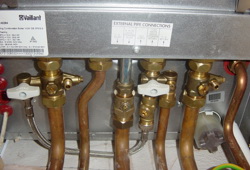 This is another integrated filling loop for a popular Vaillant combi boiler.
This is another integrated filling loop for a popular Vaillant combi boiler.
It is a Vaillant ecoTEC plus range filling loop for a combi boiler (824 to 837). There are two white plastic knobs, both need to be opened to get water in. Don't foget to close both of them after filling, otherwise you will get over filled. Again this method is in boiler instructions, and there are plenty YouTube video clips on this, here is one.
Ideal Logic is another popular boiler, here is its filling loop.
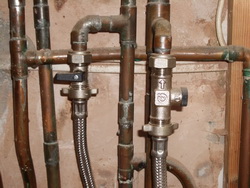 Here is another common used filling loop, the second type - external filling loop. It is used on some old combi boilers. The siliver braided hose is the filling loop. Normally there are two knobs at the each end, but some just have one. Use hands or tools to open.
Here is another common used filling loop, the second type - external filling loop. It is used on some old combi boilers. The siliver braided hose is the filling loop. Normally there are two knobs at the each end, but some just have one. Use hands or tools to open.
After a filling an external filling loop is meant to be removed to comply with water regulations, but most of them are still left connected.
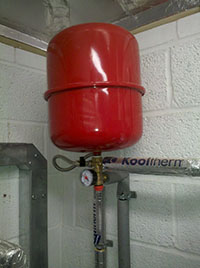 The left is another external filling loop, not for a combi boiler, but for a bigger system called unvented system, or called Megaflow, which is consisted of a system boiler and an unvented hot water cylinder.
The left is another external filling loop, not for a combi boiler, but for a bigger system called unvented system, or called Megaflow, which is consisted of a system boiler and an unvented hot water cylinder.
The filling loop is the braided hose in the picture next to the gauge.
There should be a pressure guage on the system boiler, but often there isn't a filling loop next to a system boiler. Often there is a seperate gauge in the airing cupbard where the hot water cylinder is located, and an external filling loop should be nearby there. The left is an example.
 As a local boiler and heating repair firm, we are not interested in earning money by this type of callouts, so we wrote this section as much as we can to help local people. We hope you get it done yourself, but if we come out for this sort of problems, we will charge, even if we have just repaired or serviced your boiler recently.
As a local boiler and heating repair firm, we are not interested in earning money by this type of callouts, so we wrote this section as much as we can to help local people. We hope you get it done yourself, but if we come out for this sort of problems, we will charge, even if we have just repaired or serviced your boiler recently.
Or is it better to book a boiler service with us and we will teach you on how to do this?
18. Mystery leaking on a combi boiler?
To call it a mystery leak is that it leaks occasionally, but often when a gas engineer checks its source, he or she couldn’t find where is it from. In a lot of cases, it is from AAV, auto air vent.
All combi boilers have a device called AAV. As shown above, an auto air vent (AAV) is to let air to get out, and to keep water in.
While air is getting out, the AAV is opening. When there isn’t any air, AAV is supposed to shut off to stop water coming out. But in a real world there might be some tiny particles in the system water. If there are some particles happened remaining at the seat of AAV valve, AAV is leaking, often at a slow rate.
As said to call it mystery, this leaking is often intermittent. This leak is sometimes happened right after a good boiler service.
What is the best heat only boiler in the current market?
 There are three types of boilers now, combi boiler, system boiler, and heat only boiler.
There are three types of boilers now, combi boiler, system boiler, and heat only boiler.
A heat only boiler is working with a hot water storage cylinder. It is normally opened system by a feed and expansion cistern (smaller one compared with bigger water cistern).
The best heat only boiler, in our opinion, is Worcester Greenstar Ri range. It is very reliable and made for purpose.
Smart TRVs for each radiators, are they good?
I don’t think so, unless the boiler is given a modulation control on heating. Assume a system has 10 radiators, initially these 10 TRVs are all open, so it is good for boiler to give a good flow rate. But eventually there is only one TRV still opening, ideally the boiler should be modulated down to min output to avoid cycle.
Modulation control is either by OpenTherm or weather compensation (WC).
Another reason is that it has a high rate for call back due to signal problems. This wasn't an installation problem, but we would still come back as warranty calls and can't charge.
Prev |
1 |
![]() Herts Boilers also maintain this blog site: https://www.boilerblog.co.uk/
Herts Boilers also maintain this blog site: https://www.boilerblog.co.uk/
